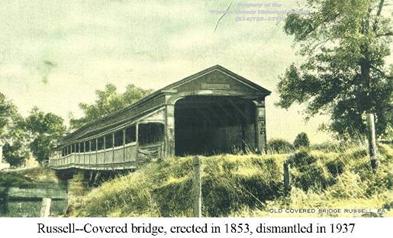
Pine Grove Township

Established in 1821, Pine Grove Township lies in the northeast part of the county, just below the New York state line. The Conewango Creek cuts north-south through the township and eventually joins the Allegheny River in Warren Borough. The largest community in Pine Grove Township is Russell. .jpg)
The first European-American settlers in the township found large stands of fir and other trees. Lumber quickly became the most important industry in the township as people cut the trees, made them into rafts, and floated them down the Conewango Creek to the Allegheny River. From the Allegheny River, rafts could travel to Pittsburgh and other market towns where they were broken up and sold. Rafting was done in the springtime when the water in the Conewango was high from rain and melting snow.
In the community of Russell, pilots were often hired to guide rafts over the rapids, which lay just below the town, and into the Allegheny River. During rafting season, Russell was a very busy town. In the 1887, History of Warren County it states, “The whole male population seemed to depend upon going down the river as often as possible--and many thereby became intimately acquainted with the rivers, their windings and their intricate channels, from here to the falls of the Ohio.” Hotels and boarding houses filled up with lumbermen and raftsmen in .jpg) the spring. In one hotel alone it was noted that, “the ball-room, dining-room, bar-room, halls and even barn floors belonging to the tavern of Thomas Slone (were) completely covered with lumbermen who were glad to get any...shelter for the night.”
the spring. In one hotel alone it was noted that, “the ball-room, dining-room, bar-room, halls and even barn floors belonging to the tavern of Thomas Slone (were) completely covered with lumbermen who were glad to get any...shelter for the night.”
People quickly built saw-mills along the creeks in Pine Grove in order to cut the trees into shingles, building lumber, and other materials. Other types of mills were important to the township as well. There were a number of grist mills, which ground farmer's grain into flour. In 1827, a carding and cloth-dressing mill was built in Russell, which helped process wool and turn it into cloth. The earliest mills relied on water power and were built next to creeks and streams in the township. Later, mills might use steam power, the machinery for which could be placed anywhere.
The village of Russell was first called Pine Grove, just like the township. It was later changed to Russelburg, named after Robert Russell. Robert Russell was the son of John Russell, one of the township’s earliest settlers. The village of Russell was not regularly laid out until 1843, but people lived and worked in the area much earlier. .jpg)
In 1871, the Dunkirk, Allegheny Valley and Pittsburgh Railroad was built through Russell, making transportation much swifter and more convenient. Russell was an active community in the late nineteenth century with stores and businesses, which included saw mills, grist mills, general merchants, a feed store, a shoe and boot maker, a hardware store, a harness shop, blacksmith shops, a wagon-maker, a steam cider mill, jelly factory, a creamery, and others.
In the early twentieth century, the streetcars also connected Russell to Warren, Jamestown and beyond. Streetcar companies often built parks along their lines to encourage business. Just below Russell, a streetcar park called “Ferncliff” was built. Although the cars stopped running in 1929, people continued to use the park until World War II.
Today, Russell remains an important community in Warren County although many of the people who live in the village work elsewhere. The Conewango Creek continues to run through town, but it no longer carries rafts downriver, and trains no longer run through town. Today, roads take people in and out of the community by car.
Courtesy of the Warren County Historical Society